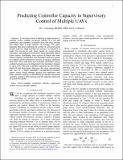Predicting Controller Capacity in Remote Supervision of Multiple Unmanned Vehicles
Author(s)
Cummings, M.L.; Mitchell, P. J.
DownloadCummingsMitchell07.pdf (544.8Kb)
Metadata
Show full item recordAbstract
In the future vision of allowing a single operator to remotely control multiple unmanned vehicles, it is not well understood what cognitive constraints limit how many vehicles and related tasks a single operator can manage. This paper illustrates that when predicting the number of unmanned aerial vehicles (UAVs) a single operator can control, it is important to model the sources of wait times caused by human-vehicle interaction, especially since these times could potentially lead to system failure. Specifically, these sources of vehicle wait times include cognitive reorientation and interaction wait time, queues for multiple vehicle interactions, and loss of situation awareness wait times. When wait times were included, predictions using a
multiple homogeneous and independent UAV simulation dropped by up to 67%, with loss of situation awareness as the primary source of wait time delays. Moreover this study demonstrated that even in a highly automated management-by-exception system, which should alleviate queuing and interaction wait times, operator capacity is still affected by situation awareness wait time, causing a 36% decrease over the capacity model with
no wait time included.
Date issued
2008Publisher
IEEE
Citation
Cummings, M.L., & Mitchell P.J., Predicting Controller Capacity in Remote Supervision of Multiple Unmanned Vehicles, IEEE Systems, Man, and Cybernetics,Part A Systems and Humans, 38(2), p. 451-460, 2008.
Keywords
multiple unmanned vehicles, supervisory control, Fan-out, operator capacity